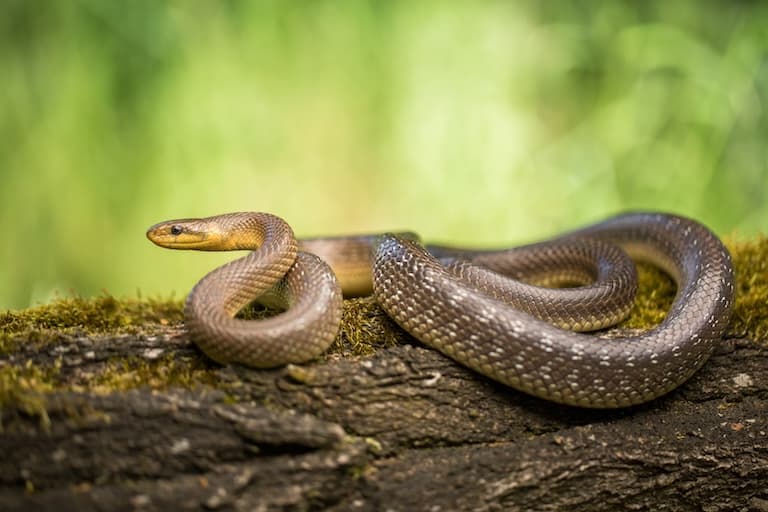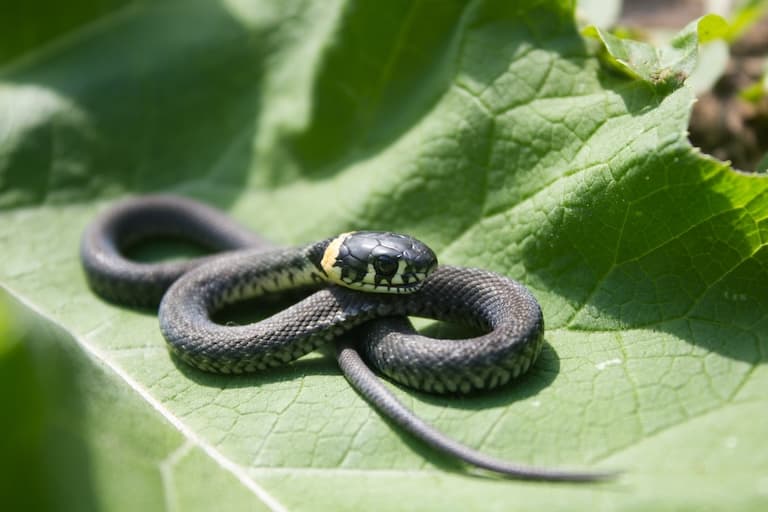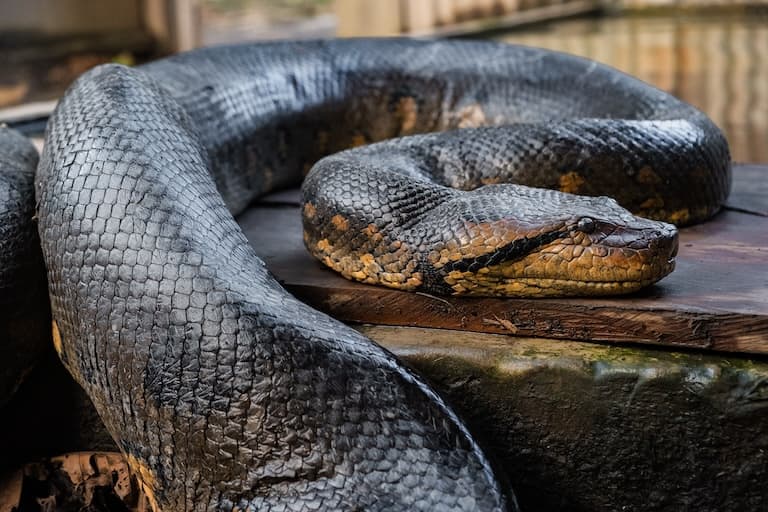Snake Profile
Ever since a snake made us ashamed of our genitals, we as a species have resented the entire serpentine collective. Today, we have yet to shed that biblical grudge, and these hangups have led to the perpetuation of a fear that we really need to overcome as a team.
Snakes kill tens of thousands of people each year, so that’s easier said than done. Though, as it turns out, not by much.

Snake Facts Overview
| Habitat: | Terrestrial, arboreal, aquatic, both freshwater and marine; all climates except Antarctic |
| Location: | Every continent except Antarctica |
| Lifespan: | 40+ years in large species |
| Size: | Up to 6 metres (20 ft) |
| Weight: | Up to 230 kg (500 lb) |
| Colour: | Varied |
| Diet: | All are predators of smaller animals |
| Predators: | Raptors, Mammals, fish, crocodilians |
| Top Speed: | Up to 17 km/h (10.5 mph) |
| No. of Species: | Over 4,150 |
| Conservation Status: | Full range, from Least Concern to Critically Endangered |
Snakes are incredible animals: each one a specialist in one way or another. They can hunt bats in the dark, squeeze, inject, or swallow whole, and they come in all shapes, colours and sizes. Yet, nobody has quite figured out when or how they evolved from lizards.
Despite their enduring infamy, these are cautious, solitary animals that just want to be left alone, and with a few tweaks in human behaviour, we should be able to grant them that privilege.
Interesting Snake Facts
1. Nobody knows where they all came from
Snakes do not fossilise well. Add to this that lizards have evolved leglessness at least 25 times convergently, and things get quite complicated when trying to figure out who belongs where within the snake clade.
There’s a difference between legless lizards like the slow worms and true snakes, but where precisely the line is drawn fades somewhere into the Mesozoic, during the dinosaur periods. The earliest confirmed snake fossils are Cretaceous, but it’s thought that they evolved much further back in the Jurassic, when burrowing or swimming lizards decided to first ditch their limbs.
Interestingly, these lizards may have been varanids – monitor lizards, and the ancestors or descendants of the infamous Mosasaurs who patrolled Cretaceous marine niches as top sea monsters.
So, Komodo dragons are likely more closely related to snakes than they are to other lizard lines, like geckos. But the jury is still out on lizard and snake relations, so we might have to wait and see.
2. They are diverse
Regardless of where and when they came from, and indeed if they all came from the same ancestor in the first place, snakes are here now, and we’d better get used to it.
There are over 4,000 species of snakes documented, and they have conquered all niches except aerial ones. There are snakes underground, snakes in the trees, snakes in the water, – both marine and freshwater; snakes on a plane, snakes that give birth to live young, snakes that can leap out of trees and snakes that play dead.
There are biting snakes, squeezing snakes, squeezing and biting snakes, snakes with venom that can kill you in 20 minutes and snakes that can shoot venom over 3 metres. Then, there are snakes of all colours, flavours and patterns.
There is truly a snake for all occasions. And for travelling, there are pocket-sized ones, too.
3. They can be tiny
The Barbados threadsnake can weigh half a gram and tops out at about 10 centimetres long. This is the smallest snake species known, and it hunts termites and ant larvae. Being predators, snakes can’t get any smaller than this, or their potential meals would start being bigger than they are.
So, this is about as small as it gets for snakes, but there may be no upper bound1.

4. Or worrying large
The two largest snakes are the reticulated python and the green anaconda, depending on whether you count length or weight, respectively.
Reticulated pythons can reach around six metres long (some even say 7.5 metres), and way over 150 kg, but the green anaconda can weigh 230 kg or more, and while it’s slightly shorter, it’s far thicker.
These two examples represent an ancient branch of convergently-adapting snakes who both went with camouflage and constriction as their primary feeding strategies. Boas and pythons are not very closely related at all, but fill such similar niches that in several cases they’re almost indistinguishable2.
The green tree python and the emerald tree boa, for example, are so similar that they even hang from tree branches with the same looping body posture.

5. Rear fangs
For the venomous snakes, there are plenty to choose from, but they generally fall into three main families: the elapids, the vipers, and the colubrids. Colubrids are rarely venomous at all, and when they are, they’re usually not very dangerous, but there are some exceptions.
The boomslang, for example, is highly dangerous, and there’s very little short of a total blood transfusion that can help if you’re bitten by one. There’s a specific antivenom for boomslangs, but it’s hard to come by, and to make matters worse, boomslang venom doesn’t hurt all that much, so people often ignore it until it’s far too late and their tissues are all leaking blood.
As colubrids, they are rear-fanged, and this is a very primitive form of envenomation that involves toxic saliva and the need to chew on a victim to work that venom into the wound3.
Hollow fangs came later, and these tend to be at the front of the snake’s mouth.
6. Front fangs
The “big four” in India are all front-fanged snakes: two elapids, the cobras and the krait; and two vipers, the Russel’s viper and the saw-scaled viper. These have large, hollow fangs that function as hypodermic needles and can pump venom into a victim very efficiently. These snakes typically employ a bite-and-release attack, and let the venom for the work – no chewing necessary4.
Vipers have particularly large fangs and are the fastest-striking snakes on record. Elapids contain both cobras and mambas, as well as all venomous snakes in Australia. Some have the most potent venoms known, like the black mamba and the taipans.
Usually, when a snake has the word King in its name, it means it feeds on other snakes. The King cobra, having been recorded at almost 6 metres in length, making this species the longest and heaviest known venomous snake.
But snakes got substantially larger in the past.

7. Extinct species were even bigger
Titanoboa was once considered the longest snake ever to have snaked. This terrifying prospect was over 12 metres in length and likely a 1.1-tonne ancestral boa species from the Palaeocene in South America.
Since its discovery, though, Vasuki indicus was discovered in India, estimated to have reached over 15 metres long. This would have been a member of a much older line of snakes called the Madtsoids, who were essentially proto-boas who peaked in the Cretaceous but lasted well after the dinosaurs went extinct.
8. They just want to be left alone
While Titanoboa may well have been large enough to consider humans food, snakes today very much don’t. And the ones who kill people do so by going about their lives, minding their own business, until someone steps on one.
So, it hardly seems fair to blame the snakes for this, and coexisting with these important predators is essential to maintaining a healthy ecosystem.
Unfortunately, when you’re bleeding out from a lethal hemotoxin, 6 hours from the nearest hospital, ecology is the last thing on your mind, so this is easier said than done.
Ultimately, though, snakes will avoid people at all costs, and time and time again, it’s been shown that we can indeed live alongside these ecologically critical companions with just a few simple behavioural changes on our part. Wear rubber boots, walk with a stick, and bring a torch at night5.
Snake Fact-File Summary
Scientific Classification
| Kingdom: | Animalia |
| Phylum: | Chordata |
| Class: | Reptilia |
| Order: | Squamata |
| Family: | 30 families |
Fact Sources & References
- “Snake species only seen a handful of times found after 20 years”, CNN Science.
- (2024), “Scientists discover the world’s largest snake species”, NCB News.
- ELAPl Dae(2006), “SNAKES FROM COLUBRIDS TO VIPERIDS & ELAPIDS”, SEMANTIC SCHOLAR.
- Cleuren and Evans (2021), “How snake fangs evolved to perfectly fit their food”, Monash University.
- Gray (2021), “The global fight against snake bites”, BBC.
